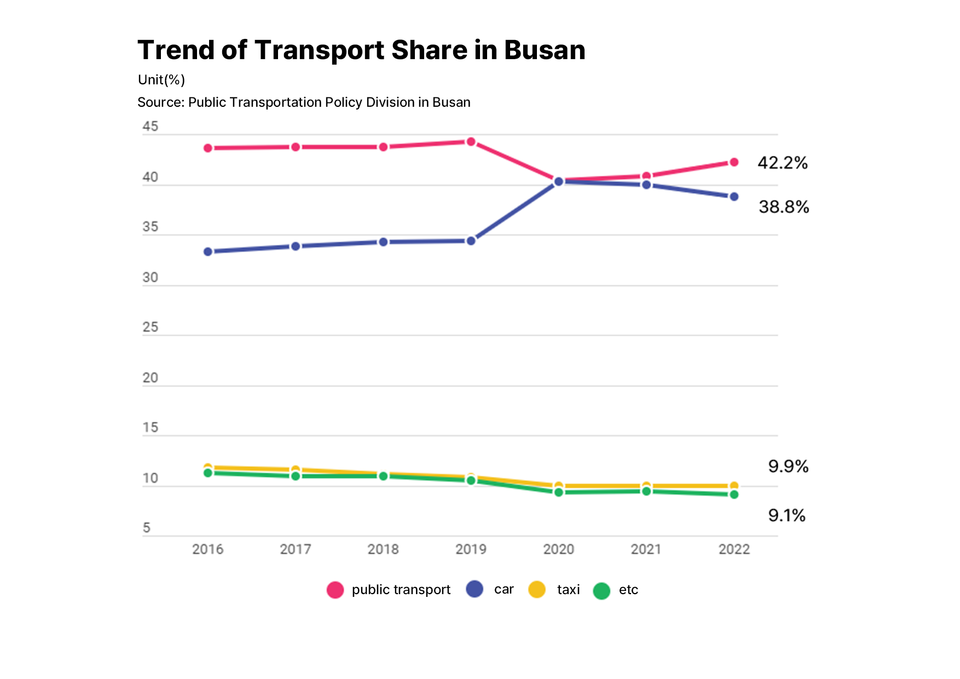Due to the deficit in public transportation operations, Busan has decided to raise transportation fares starting this month. But experts say increasing public transportation use by citizens is more important.
Busan is implementing an increase in transportation fares starting this month to solve the deficit in public transportation operations that exceeded 600 billion won last year. However, it has been pointed out that raising transportation fares without addressing the fundamental issues could lead to a more profound and more long-term deficit. There is a growing voice calling for basic structural improvements.
According to data submitted by the Busan Transportation Bureau to the Busan Metropolitan Council on July 3rd, the city bus operation deficit was 365.7 billion won as of 2022, up 101% from 2019. The subway deficit rose 28% to 292.1 billion won over the same period. The direct causes are attributed to the rise in transportation costs, such as labor and gas, and decreased passengers due to COVID-19.

Experts say structural efforts to increase transport share are needed to fundamentally resolve the deficit. In particular, the key lies in improving the transport share of passenger transportation, which accounts for the most significant proportion of the transport share. This indicates how many people a particular vehicle transports in a specific area, meaning that the higher the transport share, the more passengers. Therefore, increasing the transport share ratio will reduce the fiscal deficit accordingly. According to statistics released by the Busan Public Transportation Policy Division, the share of public transportation in Busan has remained in the 40% range since 2016. This is a significant difference compared to Seoul, which surpassed 60% before COVID-19.
In other words, to resolve the transportation deficit, it is necessary to find ways to increase the usage of public transportation. At the same time, there are concerns that the current vague plan to raise transportation fares may lead to a decrease in the usage of public transportation. Hwang Jin-Wook (Prof. of Urban Planning and Engineering, PNU) said, “An increase in public transportation fares can lead to a vicious cycle of increasing demand and operational deterioration. Raising transportation fares is only a short-term solution. For a fundamental resolution of the deficit, it is necessary to create an environment to increase the transportation share.”
However, as the convenience of using public transportation diminishes, citizens are gradually turning away from public transit. According to data released by the Busan Citizen’s Coalition for Economic Justice on August 21st, the bus interval increased by 2.4 minutes from 11.3 minutes in 2012 to 13.7 minutes in 2022. The long bus intervals was identified as the most inconvenient aspect of bus usage by the highest percentage of respondents (34.5%), according to a survey conducted by the Busan Bus Transportation Association last year. To improve the transportation share, citizens should be presented with incentives to use public transportation, but the quality of service is falling over time. Prof. Hwang said, “To increase citizens’ use, it is essential to carefully design routes and intervals, focusing on Bus Rapid Transit (BRT) and subway. The city should also make prior efforts to enhance pedestrian accessibility to public transportation.”
Busan’s “Car-centered Policy” is also one reason for the stagnant transportation share. Experts analyze that it is difficult to increase the share ratio only with public transportation-related policies without restraining car usage. In the traffic innovation policy announced by the city this year, there is only discussion about multifaceted public transportation services and quality improvement, without dealing with the direction of reducing the number of cars that continue to increase. Currently, the city's policies on vehicle suppression are all about the weekly car-free day system, public parking lot feeding, and fare adjustment. Yang Mi-Sook (Dean, Citizen’s Solidarity for Participation of Busan) said, “It is effective only when policies that benefit citizens and impose regulations are carried out at the same time. Busan seems to be passive in taking action for the necessary institutional arrangements, only considering the reactions of car users.”
Some point out that the accumulation of traffic deficits results from Busan's failure to properly operate the bus quasi-public operating system. According to the data released by the Busan Transportation Bureau, the city's annual subsidies to 33 bus companies in Busan amounted to 300 billion won as of last year, more than 82% of the deficit. Nevertheless, questions were raised about the persistent deficit. Dean Yang said, “The deficit would not be only a matter of decreased income.” In fact, according to the “Operation Status of the Local Government's City Bus Quasi-public Operating System” announced by the Board of Audit and Inspection in 2021, 71.3% of Busan's actual bus operations were not reported. However, the city did not assess the responsibility, resulting in the omission of over 65.2 billion won in fines that the city should have imposed on some bus companies.
Currently, Busan is in the process of developing various policies to increase the share of public transportation. As part of its medium and long term plans, the city aims to achieve a 60% public transportation share through initiatives such as big data-based route adjustments, introducing Mobility as a Service (MaaS), establishing shared Personal Mobility (PM) and public transportation transfer services, introducing Demand Responsive Transport (DRT), and connecting subway lines 1 and 2. However, as the causes of the public transport deficit are complex, finding fundamental solutions to policies centered on public transportation and measures to curb car usage remains a persistent challenge.
Reporter You Seung-Hyun
Translated by Kim Tae-Yi

